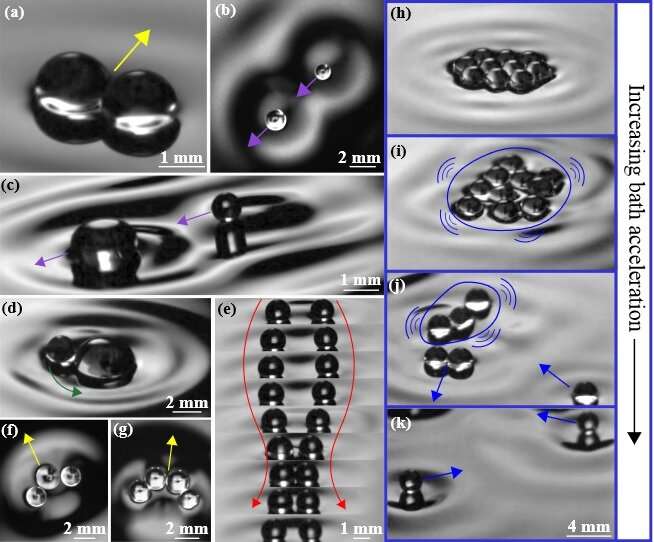July 26, 2019 feature
When droplets walk across a liquid surface

When a container of silicone oil or other similar liquid is vertically shaken at a regular frequency, 1-millimeter-sized droplets of the same liquid placed on the liquid's surface appear to "walk" across the surface at speeds of about 1 cm/second, propelled by their own waves. In a new study, physicists have found that these walking droplets can be much larger (up to 2.8 mm in diameter) and faster (5 cm/second) than previously observed. These "superwalkers" exhibit a wide range of never-before-seen behaviors, including novel synchronized movements.
One of the interesting features of walkers is that, while their movements can be completely explained by classical mechanics, some of their behaviors mimic certain quantum phenomena that typically exist only at the atomic scale. Examples of such features include tunneling, quantized orbits, and correlations among multiple droplets. In a sense, droplet mechanics could be viewed as a combination of classical and quantum mechanics, where both particle and wave behaviors coexist.
Researchers Rahil Valani and Anja Slim at Monash University, and Tapio Simula at Swinburne University of Technology, have published a paper on the superwalkers in a recent issue of Physical Review Letters.
"Superwalkers open a whole new world to explore within the research area of walking droplets that have already shown exotic behaviors," Simula told Phys.org.
To create a normal-sized walker, a container of liquid is vertically shaken at a regular frequency, such as 80 Hz. In the new study, the researchers showed that when the liquid is simultaneously driven by two frequencies—for example, 80 Hz and its subharmonic frequency 40 Hz—droplets placed on the surface become superwalkers. To create the superwalkers, the researchers either used a syringe (for larger superwalkers) or quickly submerged and extracted a needle from the liquid (for smaller ones).
Due to their large size, superwalkers have large inertia, meaning they resist change. Superwalkers can use their inertia to overcome the wave barrier that normally prevents walkers from coming in contact with each other. As a result, these superwalkers can more strongly interact with each other due to their overlapping wave fields. This interaction leads to a great deal of new and interesting behaviors, some of which are shown in the videos.
For example, superwalkers can tightly bind together in pairs or groups, separated only by a very thin layer of air. If they have different sizes, they move in a circular path, but if they have the same size, they travel in a straight line.
Under other conditions, superwalkers behave as "chasers," where smaller superwalkers will chase after larger ones, sometimes forming long trains. Other times, the superwalkers form "promenading pairs," in which they walk side by side, bouncing off each other.
Sometimes superwalkers will orbit each other, like binary stars, which is something that normal-sized walkers do as well. But superwalkers exhibit the novel feature that they intermittently reverse their orbiting direction if one superwalker is larger than the other.
By tweaking the oscillation amplitudes and frequencies, the researchers uncovered other new behaviors. For instance, at low driving amplitudes of the 40-Hz vibration, the superwalkers take on a crystal configuration. As the amplitude is gradually increased, the superwalkers begin to jiggle, then lose their crystal structure, and finally begin to rapidly bounce off each other like billiard balls. The researchers compared these dynamics to solid-liquid-gas phase transitions, with the amplitude acting as the temperature parameter.
When slightly detuning the subharmonic frequency to 39.5 Hz, the researchers observed the superwalkers exhibit synchronous stop-and-go motion, in which they all walk in synch with each other, and then stop at the same time, and then walk again. The researchers explain that this behavior occurs because the continuously varying phase difference between the two frequencies causes the superwalkers to switch back and forth between the superwalking and bouncing regimes.
The researchers expect that future research will reveal more insight into the quantum features of superwalkers.
"These walking droplets form a fascinating dynamical system where the droplet on each bounce creates a wave around itself, and these waves in turn guide the motion of the droplet, resulting in a moving wave-droplet entity," Valani said. "The walkers have been shown to mimic several quantum features, and it will be interesting to explore how superwalkers behave in such experiments."
More information:
Rahil N. Valani, Anja C. Slim, and Tapio Simula. "Superwalking droplets." Physical Review Letters. DOI: 10.1103/PhysRevLett.123.024503
Also at arXiv:1807.06879 [physics.flu-dyn]
Journal information: Physical Review Letters
© 2019 Science X Network



















